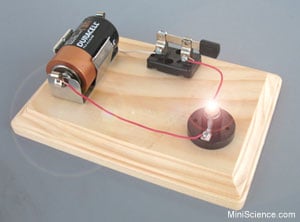mNo edit summary |
m (Standardize wikitext) |
||
| (15 intermediate revisions by 6 users not shown) | |||
| Line 1: | Line 1: | ||
[[File:simple1.jpg|thumb|A simple electrical circuit.]] | |||
[[ | '''Electricity''' is the phenomena that an electric charge runs from the positive part of a circuit to the negative part. Electricity is thus a way to transmit and [[Energy storage|store energy]]. It is not a source of energy itself. | ||
=== The mains electricity grid === | |||
The mains electricity grid makes it possible for energy produced in large remote [[nuclear]], [[hydroelectric]] or [[Coal]] fired power stations to be transmitted across the country to be used in homes, factories and offices in far away cities. | |||
The mains electricity grid makes it possible for energy produced in large remote [[nuclear]], [[hydroelectric]] or [[Coal]] fired power stations to be transmitted | |||
A nationwide or continental electricity grid also means that remote alternative energy sources, such as [[Wind power|wind]] or | A nationwide or continental electricity grid also means that remote alternative energy sources, such as [[Wind power|wind]] or Wave power, can be brought to users in cities. A continental grid can also be used with alternative energy sources whose capacity varies depending on the tides and the weather so that a shortfall in one area can be made up by supplies from elsewhere. | ||
===Improving the efficiency of the mains electricity grid=== | ==== Improving the efficiency of the mains electricity grid ==== | ||
Note that the Carbon rating of electricity (the number of kilograms of [[carbon dioxide]] released into the atmosphere for each kWhr of electricity) varies depending on the ratings of the power stations supplying the grid. | |||
All of this however depends on a large infrastructure of extra high voltage transmission lines, large power stations, users being concentrated in cities. A more appropriate energy infrastructure would depend on local energy sources, controlling the loads to match the available power. | |||
Besides adopting a [[Autonomous houses and neighbourhoods|local power system]] (still hooked up to the mains electricity grid so as to allow [[net metering]]), it is also beneficial to make the grid more cost-effective. This can be done by implementing a uniform system globally (230V/50Hz). | Electricity can be a part of such a local power system, being used as a medium to convert wind, solar, small hydro, biogas into one common form which can more easily be used for [[lighting]], communications, pumps and which can be [[Energy storage|stored]] in [[Batteries]]. | ||
Besides adopting a [[Autonomous houses and neighbourhoods|local power system]] (still hooked up to the mains electricity grid so as to allow [[net metering]]), it is also beneficial to make the grid more cost-effective. This can be done by implementing a uniform system globally (230V/50Hz). In addition to this, either CEE 7/7 plugs and sockets can be used globally, or industrial CEE power plugs and sockets can be used (3P+N+E){{W|Industrial and multiphase power plugs and sockets}} This eliminates the need to convert the power yet again from 3-phase to 2-phase power, and thus improves efficiency and reduces cost. Alternatively, perfected single wire earth returns{{W|Single wire earth return}}; e.g. Tunisia's MALT{{W|MALT}}-system, which features low costs and easy placement) could be used but this is far less efficient.<ref>[https://web.archive.org/web/20170912035732/http://ruralpower.org/ SWER-mains electricity system advantages]</ref><ref>[https://web.archive.org/web/20110811030804/http://practicalaction.org:80/practicalanswers/product_info.php?products_id=293 Description of Tunisia's MALT-system]</ref> | |||
=== See also === | |||
* [[Desertec]] | * [[Desertec]] | ||
== | === References === | ||
<references /> | |||
{{Page data}} | |||
[[Category:Energy]] | [[Category:Energy]] | ||
[[Category:Electricity]] | [[Category:Electricity]] | ||
Latest revision as of 21:49, 23 May 2024

Electricity is the phenomena that an electric charge runs from the positive part of a circuit to the negative part. Electricity is thus a way to transmit and store energy. It is not a source of energy itself.
The mains electricity grid[edit | edit source]
The mains electricity grid makes it possible for energy produced in large remote nuclear, hydroelectric or Coal fired power stations to be transmitted across the country to be used in homes, factories and offices in far away cities.
A nationwide or continental electricity grid also means that remote alternative energy sources, such as wind or Wave power, can be brought to users in cities. A continental grid can also be used with alternative energy sources whose capacity varies depending on the tides and the weather so that a shortfall in one area can be made up by supplies from elsewhere.
Improving the efficiency of the mains electricity grid[edit | edit source]
Note that the Carbon rating of electricity (the number of kilograms of carbon dioxide released into the atmosphere for each kWhr of electricity) varies depending on the ratings of the power stations supplying the grid.
All of this however depends on a large infrastructure of extra high voltage transmission lines, large power stations, users being concentrated in cities. A more appropriate energy infrastructure would depend on local energy sources, controlling the loads to match the available power.
Electricity can be a part of such a local power system, being used as a medium to convert wind, solar, small hydro, biogas into one common form which can more easily be used for lighting, communications, pumps and which can be stored in Batteries.
Besides adopting a local power system (still hooked up to the mains electricity grid so as to allow net metering), it is also beneficial to make the grid more cost-effective. This can be done by implementing a uniform system globally (230V/50Hz). In addition to this, either CEE 7/7 plugs and sockets can be used globally, or industrial CEE power plugs and sockets can be used (3P+N+E)W This eliminates the need to convert the power yet again from 3-phase to 2-phase power, and thus improves efficiency and reduces cost. Alternatively, perfected single wire earth returnsW; e.g. Tunisia's MALTW-system, which features low costs and easy placement) could be used but this is far less efficient.[1][2]